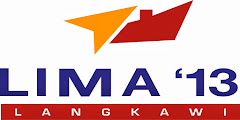25 Juni 2009
 Elbit Systems/Rockwell Collins Helmet Mounted Display System (photo : Defense Industry Daily)
Elbit Systems/Rockwell Collins Helmet Mounted Display System (photo : Defense Industry Daily)The Elbit Systems/Rockwell Collins joint venture Vision Systems International, LLC recently announced $54.1 million in contracts. These awards will begin production of their Helmet Mounted Display System (HMDS), which will equip all American and exported F-35 fighters. The contracts will cover low rate initial production (LRIP) Lots 1, 2 and 3, and run through 2012. They include Lockheed Martin’s purchase of 52 F-35 Gen II Helmet Mounted Displays, and 30 aircraft shipsets. VSI also received contracts for production tooling and initial funding for the Pilot Fit Facility Standup at Eglin Air Force Base, FL.
HMDS is a significant advance over its predecessors – which are themselves a significant advance over a technology that changed fighter pilots’ worlds in the 1960s and 1970s…
When they entered widespread military use in the 1970s, Heads-Up Displays (HUD) that superimposed range and targeting information on a clear pane of glass at the head of the cockpit were revolutionary. Pilots no longer had to look down at their instruments in order to see critical information. Which meant that they didn’t have to take their eyes off of the ultra-fast action outside their plane. This was exceptionally useful to strike aircraft designed to fly and fire at altitudes below 100 feet. It soon proved equally useful to fighter pilots engaging enemy aircraft.
Unlike the last 2 generations of fighters, however, F-35s won’t be built a HUD. Instead, they’ll take the next step, moving those functions and more to a display that’s part of the pilot’s helmet.
 HMDS during testing in Britain (photo : Defense Industry Daily)
HMDS during testing in Britain (photo : Defense Industry Daily)Like the HUD, HMDS allows the pilot to be “eyes out” at all times. Unlike a traditional HUD, but like all helmet-mounted displays (HMD) such as VSI’s popular JHMCS, it also works no matter where that pilot looks. This is especially useful when targeting modern missiles, whose wide seeker cones and “lock-on after launch” guidance give them tremendous flexibility.
HMDS is a next-generation HMD that shortens latency, while adding functions like sensor imagery/ synthetic vision, threat alerts – and even full 360 degree awareness, thanks to linked sensors like DAS that are embedded around the F-35.
On the flip side, increasing helmet weight in a vehicle that can pull 9gs has its drawbacks. Systems like HMDS are spawning revised pilot ejection safety research, introducing new neck exercises for pilots, and of course sparking preliminary testing of HMDS itself for comfort, fit, and stability.










if you know more information about teacherhabits then pelease cleak the link word.
BalasHapus